Vegetable gardening is a popular pastime for many people in Florida. In addition to being fun, the vegetables just seem to taste better when they are homegrown. Unfortunately, humans are not the only creatures who eat vegetables. Most gardeners have had the experience of putting hours of hard work into a garden expecting a bountiful harvest only to have it lost due to some problem. Who are the culprits? They may be things we can see, like rabbits, birds, or insects, or they may be invisible, too small to be seen. Due to our warm temperatures, sandy soil, and humidity, Florida has more than its fair share of microscopic pests and pathogens. Plant-parasitic nematodes (Figure 1) can be among the most damaging and hard-to-control of these organisms.
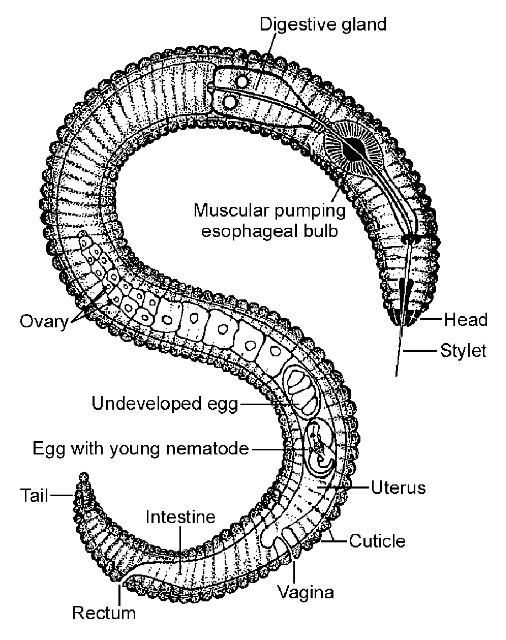
Credit: R. P. Esser, Florida Department of Agriculture and Consumer Services, Division of Plant Industry; used with permission.
What are nematodes?
Nematodes are unsegmented roundworms, different from earthworms and other familiar worms that are segmented (annelids) or in some cases flattened and slimy (flatworms). Many kinds of nematodes are found in Florida soil. Most nematodes are beneficial, feeding on bacteria, fungi, or other microscopic organisms, and some may be used as biological control organisms to help manage important insect pests. However, plant-parasitic nematodes (Figure 1) feed on live plants and are detrimental to the garden.
Plant-parasitic nematodes are very small, and most can only be seen using a microscope (Figure 2). All plant-parasitic nematodes have a stylet or mouth-spear that is similar in structure and function to a hypodermic needle (Figure 3). The stylet is used to puncture plant cells and then inject digestive juices and ingest plant fluids. Most of the plant-parasitic nematodes that are important in vegetable gardens feed on plant roots. Some plant-parasitic nematodes, called ectoparasites, remain in the soil during their entire lifecycle and feed by inserting only their stylet into the root (Figure 4). Other nematodes enter the plant with part or all of their body and are called endoparasites. Some endoparasites, called migratory endoparasites, burrow around inside the root (Figure 5). Other endoparasites, called sedentary endoparasites, establish permanent feeding sites inside the root and remain in one place. As it matures, a sedentary endoparasite's body changes shape and adult females are usually swollen (Figure 6).

Credit: W. T. Crow, UF/IFAS Entomology and Nematology Department

Credit: R. P. Esser, Florida Department of Agriculture and Consumer Services, Division of Plant Industry; used with permission.
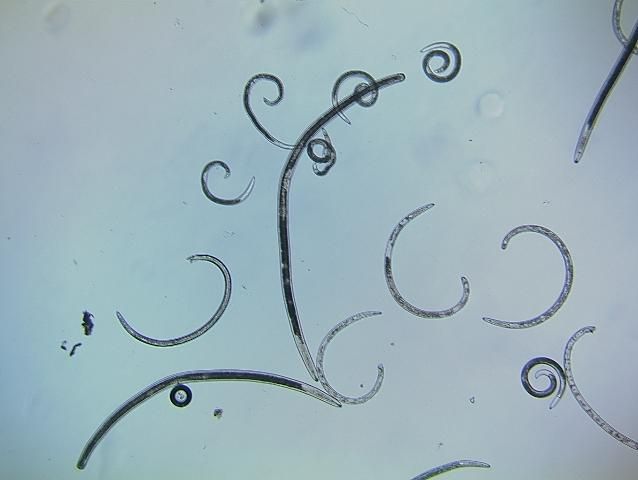
Credit: W. T. Crow, UF/IFAS
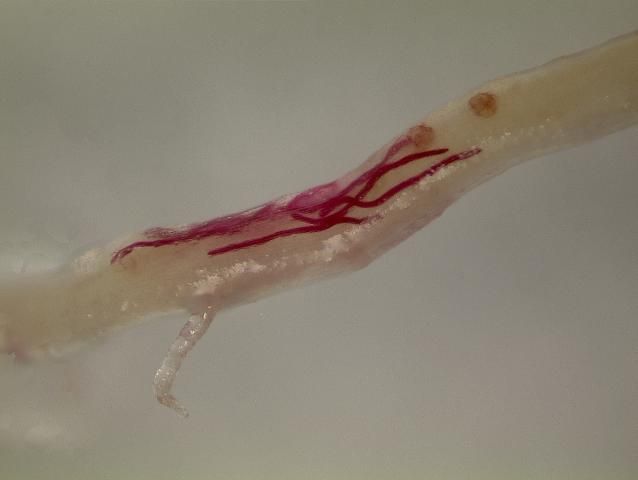
Credit: A. C. Hixson, UF/IFAS
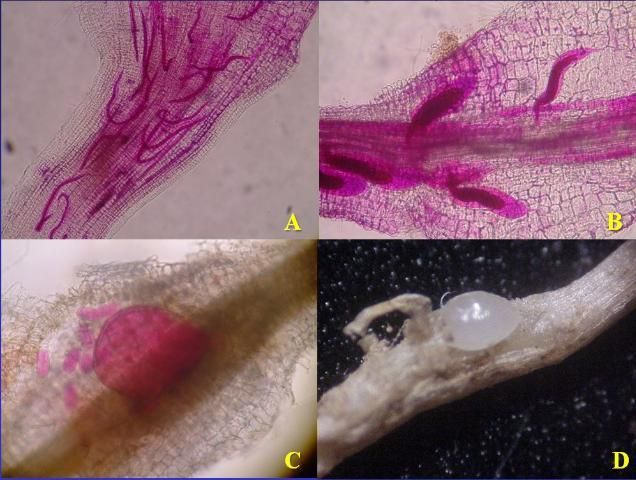
Credit: Panels A, B, and C, N. A. Sikora UF/IFAS; Panel D, Theresa Friday UF/IFAS Extension
How do nematodes damage plants?
As plant-parasitic nematodes feed, they damage the root system and reduce the ability of a plant to obtain water and nutrients from the soil. When nematode numbers get high, and/or when environmental stresses occur, aboveground symptoms may become evident. Aboveground nematode symptoms often resemble nutrient deficiencies or drought stress. Symptoms include yellowing, wilting, and stunting (Figure 7, 8, 9).

Credit: D. W. Dickson, UF/IFAS
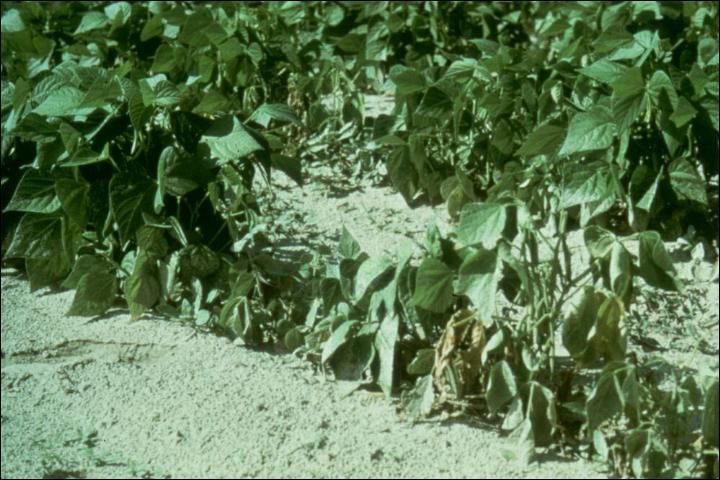
Credit: R. A. Dunn, UF/IFAS
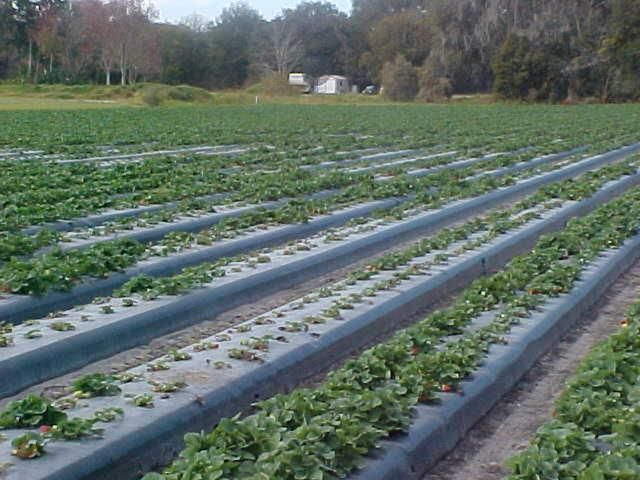
Credit: J. Hamill, UF/IFAS
Nematode symptoms occur because the damaged roots cannot take up water and nutrients from the soil properly. If planted into beds that already have high numbers of plant-parasitic nematodes, plants may become stunted and slowly die. Transplants may not grow at all after planting. For plants with belowground edible parts like carrots (Figure 10) or potatoes, nematodes also can damage the plant parts we intend to eat.
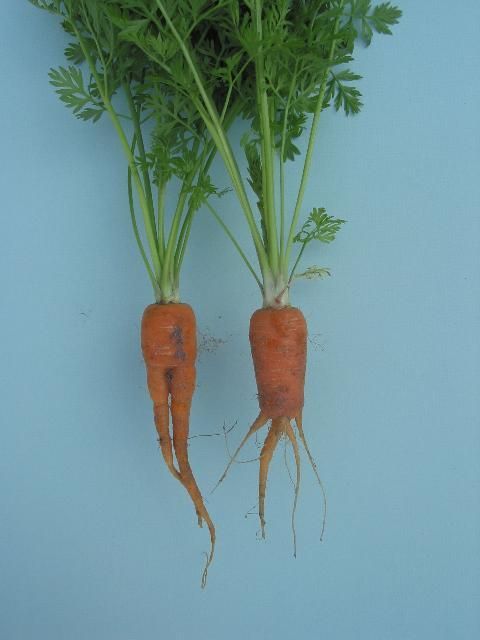
Credit: W. T. Crow, UF/IFAS
Nematode damage usually occurs in localized areas that may enlarge slowly over time. Be aware that similar conditions may be caused by other factors such as localized soil conditions, fungal diseases, or insects. While other types of nematodes may damage vegetable gardens on occasion, in Florida the most common are root-knot, sting, awl, and stubby-root nematodes.
Root-Knot Nematodes
Root-knot nematodes are the most well-known of the plant-parasitic nematodes. There are several species that are common in Florida including Meloidogyne incognita, M. arenaria, M. javanica, and M. enterolobii. These are sedentary endoparasites that enter roots and remain in one place. The nematodes inject hormones into the roots that cause knots or galls to form (Figure 11). These galls are easily recognized. Root-knot nematodes cause extensive damage and changes in the root system. These changes also allow fungi and bacteria to get into the plant. Some of these secondary organisms cause rotting of the root systems, and others cause vascular wilts. Sometimes the damage caused by the nematodes and the other organisms together is worse than that caused by either organism separately. Root-knot nematodes are one of the most destructive plant-parasites. High infestations can kill many types of vegetables. Some of the vegetables that are most commonly damaged by root-knot nematodes are tomatoes, potatoes, okra, beans, peppers, eggplants, peas, cucumbers, carrots, field peas, squash, and melons.
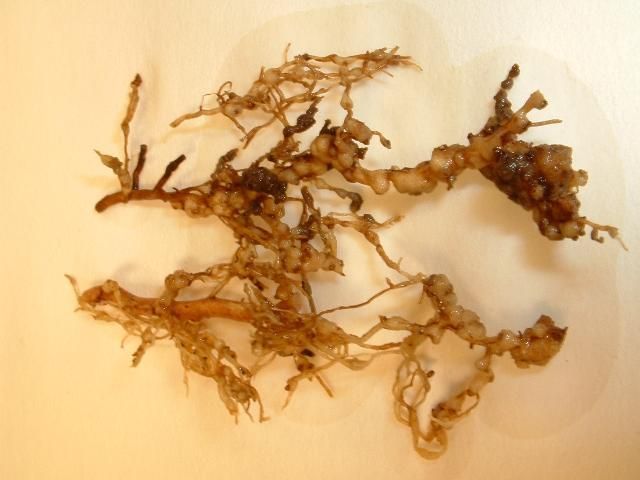
Credit: R. Levin, UF/IFAS
Ectoparasites
There are several ectoparasitic nematodes capable of causing severe damage to vegetables in Florida. The most destructive of these are the sting, awl, and stubby-root nematodes. Feeding by these nematodes usually causes roots to be stunted or to look stubby (Figure 12). There is no type of vegetable that is not attacked by one or more species of ectoparasitic nematodes. Sting nematodes are found in sandy soil and are common throughout much of Florida. Awl nematodes are usually found in wet habitats such as near ditches, ponds, or poorly drained areas. Several stubby-root species are found in Florida; one or more can usually be found in most Florida habitats. Other ectoparasitic nematodes that parasitize some kinds of vegetables are spiral, stunt, and ring nematodes.
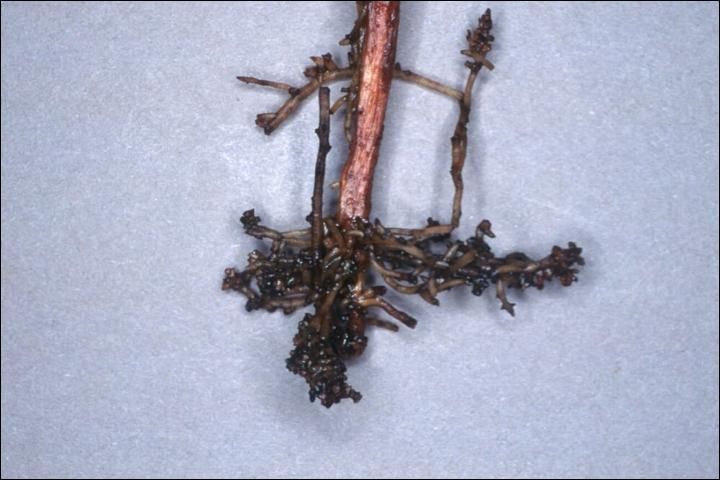
Credit: W. T. Crow, UF/IFAS
Other Nematodes
Reniform and cyst nematodes are sedentary endoparasites that occasionally damage vegetables in Florida. These nematodes do not cause galls like root-knot nematodes. Root symptoms are generally unthrifty root systems. Reniform nematodes are limited to soils with high silt content. In Florida they are found most often in the Homestead area and parts of the panhandle. Reniform nematodes are damaging to many garden crops, such as beans, field peas, tomatoes, pineapples, and sweet potatoes. Cyst nematodes are not widespread on vegetables in Florida. They are occasionally found damaging crucifers (greens, broccoli, cabbage, etc.).
Lesion and lance nematodes are migratory endoparasites that are common in Florida soils. These nematodes usually cause dark sunken areas called "lesions" on roots (Figure 13). Feeding by migratory endoparasitic nematodes can make plants susceptible to root-rot and vascular wilt diseases.
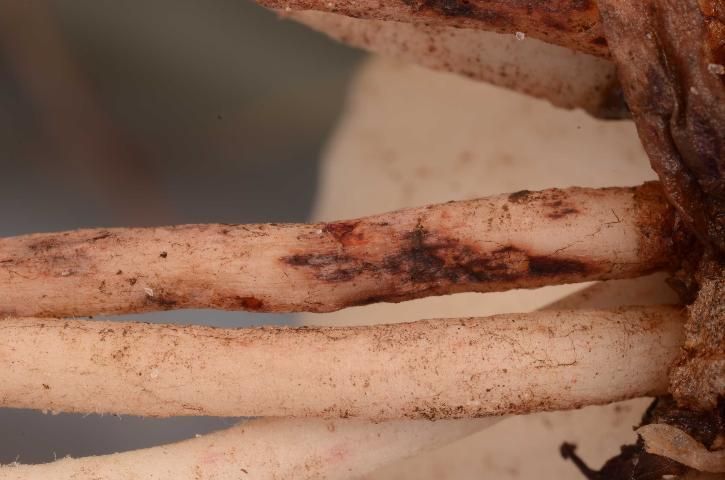
Credit: W. T. Crow, UF/IFAS
How do I know if nematodes are a problem?
With any plant problem, having an accurate diagnosis is important to address the problem and to avoid wasting effort and unnecessary pesticide applications. Often, nematode symptoms are identical to other disorders, so visual inspection is usually not enough for diagnosis. Also, gardeners may want to find out how much risk they have from nematodes before they plant their garden. The only reliable way to determine if plant-parasitic nematodes are involved in a plant problem, or to predict risk from nematodes, is by having a nematode assay conducted by a professional nematode diagnostic lab. The University of Florida Nematode Assay Lab (NAL) is such a facility. Forms and shipping and payment information are available at the NALb website: http://entnemdept.ufl.edu/nematology-assay-lab/. Some private plant diagnostic labs also can conduct nematode assays. Nematode analysis is a separate procedure and requires different sampling guidelines than those required for soil analysis or plant disease samples. Do not send samples in soil test bags! The addresses are different and, more importantly, the soil testing bags are designed to dry soil out. Drying invalidates the results of a nematode assay. The accuracy of the diagnosis depends on the quality of the sample that you submit. If you are taking a sample for submission to another lab, following the guidelines below will help ensure an accurate diagnosis.
When is the best time to sample? It is best to collect nematode samples at the end of a crop in order to predict or prevent problems for the next crop. That is when nematode numbers will be highest, and because nematode management is mostly preventative, this gives opportunity to put management tactics in place. If you do not sample at the end of the previous crop, it is best to take nematode samples well before planting, if possible. This allows you to implement management practices or decide if your garden is in a good spot.
If no plants are growing, collect soil with a shovel, trowel, or other device from 8 to 12 locations in the garden. Samples should be taken 8 to 10 inches deep. About a handful of soil from each location is adequate. Combine all the soil, mix it, and put about a pint (450 cm3) into a single plastic bag. If plants are growing, collect both soil and roots for the sample! This way the lab can find both endoparasites and ectoparasites. Dig soil and roots from around the plant. For most vegetables, samples should be taken 8 to 10 inches deep. For very small plants, you can place the whole root ball with adhering soil into the bag. If multiple plants are affected, collect some soil and roots from several plants. Place the soil and roots together in the same plastic bag. A minimum of two cups (250 cm3) of soil and 1 to 2 cups of roots are required.
Handling
- If submitting more than one sample, make sure that the outside of each bag is labeled with a permanent marker. You can also write on masking tape stuck to the bag. Do not put paper labels inside of bags, because they will decompose and be illegible.
- Seal plastic bags to keep samples moist. Dried-out samples are no good for nematode diagnosis. Self-sealing bags often come open in the mail. If using a self-sealing bag, tape the seal shut.
- Keep samples out of direct sunlight or heat. Heat and ultraviolet light kill nematodes. Even a few minutes on the dashboard or in the back of a pickup can invalidate assay results. Keep the sample in an air-conditioned room until it gets shipped.
- Fill out the information on the nematode assay form. In order to make a diagnosis, we need to know as much as possible about the plant or plants in question. Tell us what kind of plants you are growing or intend to plant.
Submitting a Sample
- Place a check or money order payable to the "University of Florida" into an envelope. If paying by credit card, fill out the credit card portion of the form or call the NAL and give it directly to them by phone. Do not send cash.
- Put the sample, assay form, and payment envelope into a box. Seal the box with gummed tape.
- Mail, ship, or deliver the samples to the NAL as soon as possible. The mailing address is Nematode Assay Lab, 1881 Natural Area Dr., PO Box 110620, Gainesville, FL 32611.
What can I do about nematodes?
Chemical Nematicides
There are no chemical nematicides labeled for use on annual bedding plants that have been effective in University of Florida trials.
Bionematicides
The bionematicide MeloCon WG contains a fungus that parasitizes nematode eggs. Results from University of Florida trials indicate that MeloCon can suppress but not eliminate root-knot and sting nematodes. When purchasing MeloCon, have it delivered directly to you from the manufacturer, and keep it frozen until it is used. To apply, mix MeloCon with water, and then either drench the planting bed with it or spray it onto the planting bed and irrigate. MeloCon works best when it is administered in multiple applications, starting before transplanting and continuing through the growing season. It is generally not effective when used to treat established plants after they have been damaged by nematodes.
Resistance and Tolerance
Plants that a particular nematode cannot reproduce on are termed resistant to that nematode. Plants that can be reproduced on by the nematode but are not damaged are termed tolerant. Table 1 lists some of the more popular vegetables grown in Florida and the nematodes that damage each one. If a nematode assay indicates a certain type of nematode is present, it is possible to plant another crop that will not be damaged by it. Some vegetable varieties are marketed as "nematode resistant." This refers to only one or two species of root-knot nematodes. These plants may still be damaged by other species of root-knot nematodes or other types of nematodes. Still, it is best to use these varieties when root-knot is present.
Soil Solarization
Soil solarization (https://edis.ifas.ufl.edu/in856) is a process of using heat from the sun to kill nematodes and other pests. The soil should be worked with a hoe or rototiller to break up clods. Remove all sticks, roots, and clumps. The soil should be moist but not wet. Cover the soil with a clear plastic tarp and bury the edges of the plastic (Figure 14). Leave the plastic on the soil for at least 4 to 6 weeks. Do not remove the plastic until you are ready to plant.
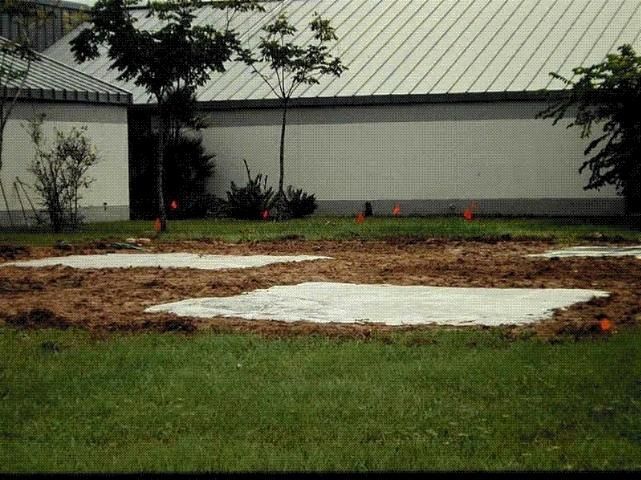
Credit: R. A. Dunn, UF/IFAS
Sunlight goes through the clear plastic and heats the soil underneath. The plastic then holds in the heat so that it penetrates and warms the soil. Long-term exposure to high temperature kills nematodes, as well as many weeds, fungi, and insect pests. The disinfested zone is usually 6 to 8 inches deep. Do not till or mix the soil after solarization. That may reinfest the soil you just solarized with nematodes from below the treated zone. Because it depends on sunlight and heat, solarization works best during the summer months. It does not work well in areas that get shade. Only solarize planting beds that get full sun.
The benefits of solarization may be enhanced by using a second layer of plastic suspended by wire hoops. An air gap is created between the two layers of plastic, giving extra insulation. Also, weeds that penetrate the first layer may then be killed by heat trapped between the plastic layers.
Cover Crops
A cover crop is a crop that is not harvested. Instead, it is planted in the season between harvestable crops. Because most vegetables in Florida are grown in the spring or fall, cover crops here are usually grown in the summer or winter. Cover crops have many benefits, including improving the soil, preventing erosion, and increasing fertility. Cover crops may also be used to decrease soil pests. Select a cover crop that is resistant to the kind of nematode that you are most concerned about. Because the nematode cannot reproduce well on the resistant cover crop, its numbers will decline over time. Nematode damage to the next crop will be less severe due to the lower population densities. This approach requires that you know which nematodes are potential problems in order to choose the correct cover crop. Not all cover crops are equally effective on all plant-parasitic nematodes. See Table 2 for a list of cover crops and their relative ability to control root-knot and sting nematodes. It is very important that weeds be kept from growing along with the cover crop. The weeds can feed the nematodes and negate the cover crop's benefits. For more information on general use of cover crops against nematodes, see https://edis.ifas.ufl.edu/vh037. Detailed information on the use of some specific cover crops to control plant-parasitic nematodes is available at https://edis.ifas.ufl.edu/in516, https://edis.ifas.ufl.edu/in531, and https://edis.ifas.ufl.edu/ng043.
Organic Amendments
Organic amendments can be added to soil as compost, manure, green manure, or other materials (https://edis.ifas.ufl.edu/vh037). Organic matter can help prevent nematode damage in several ways. The organic matter increases the ability of the soil to hold water and nutrients, and it improves soil structure. This makes a better environment for most plants and can help the plants survive in spite of the nematodes. Organic amendments can also increase natural enemies of nematodes that suppress the nematode populations. Some organic amendments can release chemicals or gases that are toxic to the nematodes.
There are several "organic" nematode management products for sale. Researchers with the University of Florida have worked with a number of these, but probably not all of them. In the majority of cases, these products work no better than adding any other, less expensive, organic material.
Planting
Nematode activity slows as soil temperatures drop. Therefore, annual plants grown in cooler months do not suffer as much from nematodes as those grown in warmer months. Become familiar with the temperature requirements of the plant and grow as early as possible in the spring or as late as possible in the fall. Older transplants generally are more resistant to nematodes than younger transplants, so older transplants should be used in nematode-infested soil. Before purchase, inspect the roots of all plants for root-knot galls or other root-related problems. Occasionally nematodes can be introduced with contaminated plants.
Soil Tillage and Root Destruction
Roots left in the soil can continue to live and support nematode reproduction. Also, endoparasitic nematode eggs attached to roots can continue to hatch. Therefore, as soon as the crop is harvested, pull up all plants and get rid of them. Till the soil with a rototiller or hoe and remove all roots that might harbor nematodes. Exposure to sunlight and drying kills nematodes, so working the soil several times can help reduce nematode populations.
Container Growing
Growing vegetables in containers off of the ground can help you avoid nematode problems. Make sure you inspect transplant roots for root-knot galls. You do not want to introduce a problem. Also use clean potting media. Do not mix potting media with native soil or you might contaminate it.
Summary
Following the recommendations listed in this document can help avoid or reduce problems with plant-parasitic nematodes in the garden. However, there are no guarantees of success. County and state faculty with the University of Florida are continually exploring new nematode management options. The most current recommendations can be obtained from the UF/IFAS Extension website, Solutions for Your Life (https://sfyl.ifas.ufl.edu/).
Table 1. List of plant parasitic nematode genera known to be of economic importance to vegetable crops in Florida.
Table 2. Effects of some cover crops on nematodes important as plant pests in Florida.